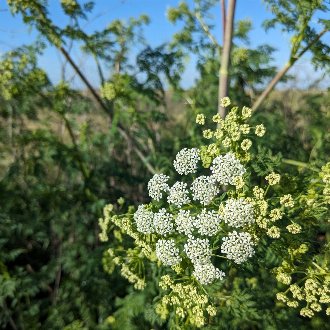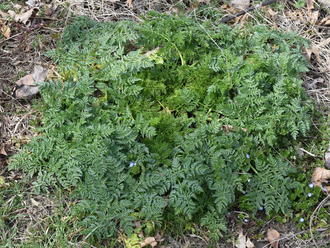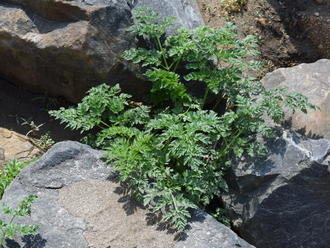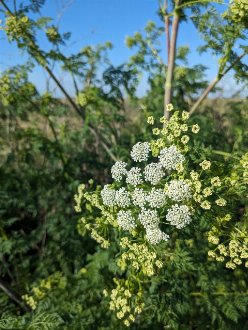Poison Hemlock (Conium maculatum L.)
↑Summary
A biennial plant, highly toxic to humans and most mammals. Native to Europe and the Middle East and widely introduced in North America.
↑Description & Identification
First-year plants consist of a basal rosette of leaves, whereas second-year plants grow upright, up to 7 feet in height, branching occasionally higher up. Leaves are alternately arranged on stems, and are doubly- or triply-pinnately compound, often resembling parsley but typically larger. The compound leaves of mature plants are quite large, up to 18" long and 12" wide, but leaflets are quite small, leading to a fernlike appearance.
Stems are hairless and are covered with dark purple splotches, with greater splotching concentrated lower down on the plant. On more heavily splotched plants, stems often appear purple from a distance.
Inflorescence is a compound umbel that superficially resembles Queen-anne's lace (wild carrot) but tends to have a round top.
The root is a white taproot, usually growing straight down but growing sideways when obstructed, and branching occasionally.
The entire plant has a foul odor, especially when bruised. Sometimes this odor can be evident even when approaching large patches of this plant.
↑Life Cycle
Poison hemlock is a biennial with a life cycle typical of the Apiaceae family. First-year plants grow only as a basal rosette, often reaching a few feet in diameter. Second-year plants bolt, growing mostly straight, and only branching occasionally near the top. Flowering occurs late spring to mid-summer, after which the seeds mature and the foliage (and then whole plant) dies. Seeds fall close to the parent plant.
Cut or mowed second-year plants will resprout from roots, especially if cut earlier in season, but will die if mowed repeatedly.
The plant generally does not spread vegetatively, but can persist by reseeding where conditions are right, sometimes forming large colonies and even monocultures.
This plant is most common in disturbed areas, where it benefits from once-or-a few-times-a-season mowing schemes that remove competition early in winter or early spring before the plant grows upright, but leave enough time for it to flower and set seed before mowing again. Basal rosettes often survive occasional mowing, but the plant cannot reproduce in regularly mowed areas.
It occasionally invades more intact ecosystems.
↑Control
This plant is often easily removed through manual uprooting. Because of this plant's toxicity it is important to wear protective gear, including long sleeves and gloves, to minimize contact with the plant's sap, and limit the time spent working with it closely.
Plants are often easiest to uproot during their second year shortly after they begin growing upright, as their stem is firm enough to grasp and uproot the entire plant. Very large plants or plants anchored in dry soil may require a shovel to uproot.
Younger plants, including first-year plants, can be dug with the help of a trowel.
Plants can be left to die in place, and usually will not re-root. However, if only the stem is broken off early in the season, the plants may resprout and bloom and still produce substantial seed.
Usually, one season of removing all plants (including both first- and second-year plants) from an area is sufficiently to greatly reduce this plant's numbers. Follow-up over the next two years will catch progressively smaller number of plants until the plant is completely eliminated from an area.
In large infestations, this plant can be greatly reduced by cutting or mowing all stems to the ground right as it begins to flower, but before it sets seed. This practice depletes the roots of nutrients and stored energy, and plants often do not have enough resources to successfully produce seed. This method may not completely prevent seed production but it can be a resource-efficient way to greatly reduce this species when it covers a large area.
↑Uses
This plant was used for executions in ancient Greece, and is well-known as the plant that killed Socrates.
↑Related Plants
This plant is the only Conium species found in North America, where it is introduced, although there are other species in this genus globally.
There are numerous members of the broader Apiaceae family in North America, overlapping with the range of this species. Relationships within this family are unclear, and it is thus not known which of these other plants is closest related to poison hemlock.
↑Notes
Poison hemlock is one of the most toxic plants to human; ingesting a small amount can kill a person. Poisonings are most common when people mistake this plant for other visually-similar members of the Apiaceae family.
↑Links & External Resources
• Conium maculatum (Poison Hemlock) | Illinois Wildflowers (About This Site)
• Conium maculatum (Poison Hemlock) | USDA PLANTS Database (About This Site)
• Conium maculatum | Go Botany (About This Site)
• Conium maculatum | Biota of North America Project (BONAP) (About This Site)
• Conium maculatum | NatureServe Explorer (About This Site)
• Conium maculatum | Missouri Plants (About This Site)
• Poison Hemlock | Maryland Biodiversity Project (About This Site)
• Conium maculatum (Poison Hemlock) | Minnesota Wildflowers (About This Site)
• Conium maculatum L. (Poison Hemlock) | Digital Atlas of the Virginia Flora (About This Site)







